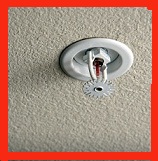Safety Corner

Fire Protection Sprinkler Systems: Fiction and Fact
The following fire safety awareness article was prepared by the Division of the Fire Marshal, ORS, NIH
FICTION #1: Sprinklers cause unnecessary water damage.
Actually, sprinkler heads are closed until heat from a fire activates them.
Only the sprinkler heads nearest the fire open up. They produce far less water than a fire hose would release.
Each sprinkler head is temperature activated; therefore, every sprinkler head does not open at the same time as is commonly depicted on TV and in the movies.
Water from the open sprinkler head(s) extinguishes or controls the fire to keep it from spreading, thus minimizing costly damage from fire or water.
FICTION #2: Sprinklers go off accidentally.
The accidental activation of a fire protection sprinkler system is, indeed, a rare occurrence. In fact, sprinkler system piping is subjected to a rigorous pressure test before the system installation is approved.
Accidents involving fire protection sprinkler systems are far less likely to occur than mishaps involving standard domestic plumbing systems.
FICTION #3: Sprinkler systems are unattractive.
In most finished areas, fire protection sprinkler system piping can be concealed above drop ceilings or in walls. Any exposed sprinkler piping may be painted to match the wall or ceiling color.
Also, some modern sprinkler heads may be virtually concealed or mounted almost flush with the wall or ceiling.
FICTION #4: Sprinkler systems are expensive.
The installation of fire protection sprinkler systems, including residential sprinkler systems, is now far less expensive than in the past. In residences this is due to the use of modern lightweight materials and designs.
It is estimated that the cost of installing a residential fire protection sprinkler system adds only one to two percent to the cost of a newly constructed home, while the homeowner could reap as much as 50 percent savings in fire insurance premiums.
In commercial properties, the cost of installing sprinkler systems could be offset by similar reduction in insurance premiums in as little as five years and could also eliminate the need for costly fire walls and fire doors that are typically required in buildings without sprinklers.
FACT #1: Each year, fires kill approximately 6,000 people in the United States and cause millions of dollars in property damage. Many deaths could be prevented and property damage minimized through the installation of fire protection sprinkler systems.
FACT #2: At NIH, we install automatic sprinkler systems in all new facilities as they are built and in older facilities during renovations. We are also installing automatic sprinkler systems throughout the residences across the NIH campus.
Of paramount importance, of course, is the number of lives saved and burns that can be prevented by these systems. They more than pay for themselves when you consider their invaluable role in saving lives and protecting our property and resources.
If you have any questions concerning fire protection sprinkler systems, please contact the Division of the Fire Marshal, Office of Research Services at 301-496-0487.